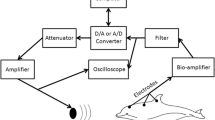Summary
Twelve sea lions (Zalophus californianus) and one harbor seal (Phoca vitulina) were examined by recording evoked potentials in response to sound from the inferior colliculus and adjacent structures, under barbiturate or after implanting and coming out of anesthesia. Results were similar in air and under water.
The averaged response evoked by a sharply rising tone consists of early, brief peaks and later, slow waves (Fig. 1). The latency of the earliest deflection is 3.5 to 4.8 ms from the moment of arrival of a sound pip at the ear. The potential increases in size with sound intensity approximately as a power function, over a dynamic range of 60–70 db (Fig. 2). Masking is qualitatively similar to that in common laboratory species.
The properties of the midbrain response are strikingly different from those in porpoises, reported elsewhere. The pinniped is not so specialized for extremely short duration, fast rise time, sounds or for rapid recovery or ultrasonic frequencies (Figs. 3, 4, 7, 8). Evoked potentials fail to show response above 30–35 kHz at 100 db SPL; best frequency is about 4–6 kHz (Figs. 5, 6). Threshold by this method is about 20 db SPL in air. Frequency modulated tones are markedly more effective in some loci but less so than in porpoises under water. The receptive field is essentially total and directionality weak, in contrast with porpoises.
Physiological results cannot settle the question whether echolocation is employed but they can indicate lack of high specialization for the types of sounds bats and porpoises use.
Similar content being viewed by others
References
Alderson, A. M., Dianantopoulus, E., Downman, C. B. B.: Auditory cortex of the seal (Phoca vitulina). J. Anat. (Lond.) 94, 506–511 (1966).
Bullock, T. H., Grinnell, A. D., Ikezono, E., Kameda, K., Katsuki, Y., Nomoto, M., Sata, O., Suga, N., Yanagisawa, K.: Electrophysiological studies of central auditory mechanisms in cetaceans. Z. vergl. Physiol. 59, 117–156 (1968).
- Ridgway, S. H.: Neurophysiological findings relevant to echolocation in marine animals. In: Orientation and navigation in animals (K. Schmidt-Koenig and M. F. Thompson, eds.). Washington: Amer. Inst. Biol. Sci. (in press).
- - Evoked potentials in the central auditory system of alert porpoises to their own and artificial sounds. (In prep.).
Evans, W. E., Haugen, R. M.: An experimental study of echolocation ability of a California sea lion, Zalophus californianus (Lesson). Bull. S. Calif. Acad. Sci. 62, 165–175 (1963).
Kitahata, L. M., Amakata, Y., Galambos, R.: Effects of halothane upon auditory recovery functions in cats. J. Pharmacol. exp. Ther. 167, 14–25 (1969).
Kohler, I.: Facial vision rehabilitated. In: Animal sonar systems (R.-G. Busnel, ed.). Laboratoire de Physiologie Acoustique. INRA-CNRZ, Jouy-en-Josas 78, France 1966.
Mohl, B.: Frequency discrimination in the common seal and a discussion of the concept of upper hearing limit. Underwater Acoustics 2, 43–54 (1967).
—: Auditory sensitivity of the common seal in air and water. J. Aud. Res. 8, 27–38 (1968a).
—: Hearing in seals. In: The behavior and physiology of Pinnipeds (R. J. Harrison, R. C. Hubbard, R. S. Peterson, C. E. Rise, R. J. Schusterman, eds.). New York: Appleton-Century-Crofts 1968b.
Poulter, T. C.: The sonar of sea lion. IEEE Trans. Ultrasonics Eng. 10, 109–111 (1963a).
—: Sonar signals of the sea lion. Science 139, 753–755 (1963b).
—: The use of active sonar by the California sea lion. J. Aud. Res. 6, 165–173 (1966).
—: Underwater vocalization and behavior of pinnipeds. In: The behavior and physiology of Pinnipeds (R. J. Harrison, R. C. Hubbard, R. S. Peterson, C. E. Rice and R. J. Schusterman, eds.). New York: Appleton-Century-Crofts 1968.
—: Sonar of penguins and fur seals. Proc. Calif. Acad. Sci. 36, 363–380 (1969).
—, Jennings, R. A.: Sonar discrimination ability of the California sea lion, Zalophus californianus. Proc. Calif. Acad. Sci. 36 (14), 381–389 (1969).
Rice, C. E.: Human echo perception. Science 155, 656–664 (1967).
Ridgway, S. H., Simpson, J. G.: Anesthesia and restraint for the California sea lion Zalophus californianus. J. Amer. vet. med. Ass. 155, 1059–1063 (1969).
Schevill, W. E.: Sea lion echo ranging? J. acoust. Soc. Amer. 43, 1458–1459 (1968).
—, Watkins, W. A., Ray, C.: Underwater sounds of pinnipeds. Science 141, 50–53 (1963).
Schusterman, R. J.: Perception and determinants of underwater localization in the California sea lion. In: Animal sonar systems (R.-G. Busnel, ed.). Laboratoire de Physiologie Acoustique. INRA-CNRZ. Jouy-en-Josas 78, France 1966a.
—: Underwater click vocalizations by a California sea lion: effects of visibility. Psychol. Rec. 16, 129–136 (1966b).
—: Experimental laboratory studies of pinniped behavior. In: The behavior and physiology of Pinnipeds (R. J. Harrison, R. C. Hubbard, R. S. Peterson, C. E. Rice and R. J. Schusterman, eds.). New York: Appleton-Century-Crofts 1968.
—, Gentry, R., Schmcok, J.: Underwater sound production by captive California sea lions, Zalophus californianus. Zoologica (N.Y.) 52, 21–24 (1967).
—, Kellog, W. N., Rice, C. E.: Underwater visual discrimination by the California sea lion. Science 147, 1594–1596 (1965).
—, Feinstein, S. H.: Shaping and discriminative control of underwater click vocalizations in a California sea lion. Science 150, 1743–1744 (1965).
Shaver, H. N.: Sea lion echo ranging. J. acoust. Soc. Amer. 43, 1458–1459 (1968).
—, Poulter, T. C.: Sea lion echo ranging. J. acoust. Soc. Amer. 42, 428–437 (1967).
Author information
Authors and Affiliations
Additional information
This study was aided by the Office of Naval Research, the Air Force Office of Scientific Research, the National Science Foundation, and the National Institute of Neurological Diseases and Stroke through grants to T. H. Bullock, and by the Naval Undersea Research and Development Center through S. H. Ridgway.
The assistance of R. F. Green in developing anatomical landmarks and that of R. H. Hamstra, Jr. in electronic problems was especially valuable. The staffs of both laboratories were the essence of cooperation.
Rights and permissions
About this article
Cite this article
Bullock, T.H., Ridgway, S.H. & Suga, N. Acoustically evoked potentials in midbrain auditory structures in sea lions (Pinnipedia). Z. vergl. Physiologie 74, 372–387 (1971). https://doi.org/10.1007/BF00341402
Received:
Issue Date:
DOI: https://doi.org/10.1007/BF00341402




